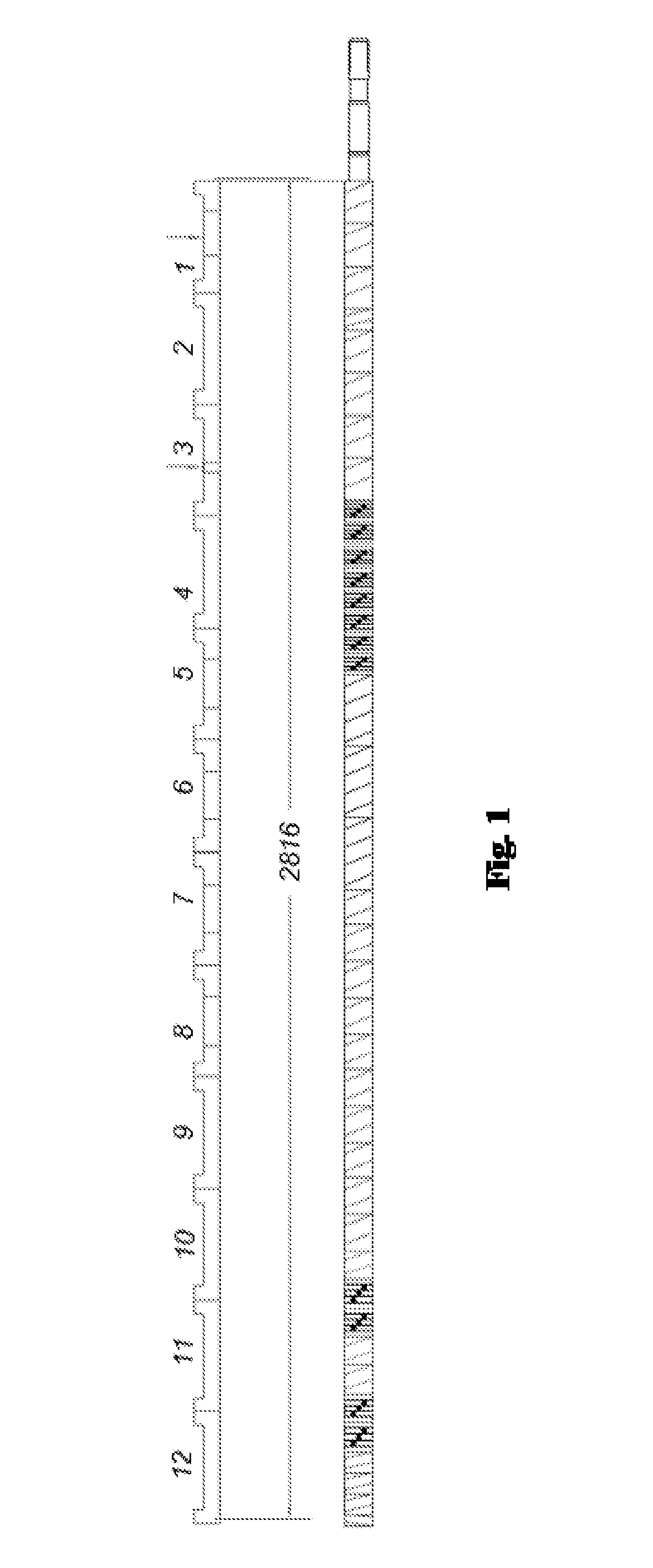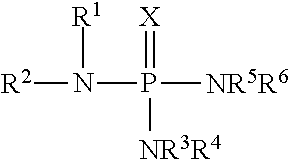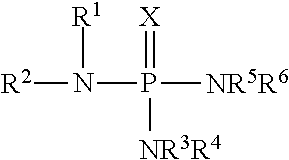Process for Producing a Powder Comprising an Extruded Carrier With an Active Compound
- Summary
- Abstract
- Description
- Claims
- Application Information
AI Technical Summary
Benefits of technology
Problems solved by technology
Method used
Image
Examples
example 1
[0074]In this Example, the screw design shown in FIG. 1 as described above was employed. Urea-formaldehyde polymer powder and liquid NBPT were fed into the extruder. The molten NBPT was fed in one batch into Zone 3. The temperature on the NBPT injection port was set at 140° F. for start up, after which the injection port temperature was adjusted to 80° F. (26.7° C.). The product rate was raised from 300 lb / hr (136 k / hr) to 500 lb / hr (227 kg / hr) by adjusting both the urea-formaldehyde polymer and NBPT feed rates. An NBPT amount above 68 wt % could not be achieved at 500 lb / hr due to freezing in the NBPT injection port. Table 1 summarizes the process parameters for this Example. In all of the runs of this Example, a dry powder was discharged from the extruder. Product temperatures were slightly above 90° F. (32° C.). Samples were evaluated using 10- or 12-mesh (standard U.S.) sieve trays at the exit of the extruder to check for agglomerates. Results of some of the sieve tests are summ...
example 2
[0075]In this Example, the screw design shown in FIG. 1 as described above was employed. Urea-formaldehyde polymer powder and liquid NBPT were fed into the extruder. The molten NBPT was fed in one batch into Zone 3. The temperature on the NBPT injection port was set at 120° F. (49° C.). The product rate was raised from 300 lb / hr (136 kg / hr) to 500 lb / hr (227 kg / hr) by adjusting both the urea-formaldehyde polymer and NBPT feed rates. Table 2 summarizes the process parameters for this Example. In all of the runs of this Example, a dry powder was discharged from the extruder. Product temperatures were slightly above 90° F. (32° C.). Samples were evaluated using 10- or 12-mesh (standard U.S.) sieve trays at the exit of the extruder to check for agglomerates. Results of some of the sieve tests are summarized in Table 3.
TABLE 2Sample2A2B2C2DTotal feed rate300lb / hr300lb / hr350lb / hr350lb / hr(136kg / hr)(136kg / hr)(159kg / hr)(159kg / hr)UFP feed rate96lb / hr96lb / hr112lb / hr112lb / hr(43.5kg / hr)(43.5kg / h...
example 3
[0077]The rotation speed for the screws was set at 110 rpm and the barrels of the extruder were maintained at 5° C. during the extrusion. N-(n-butyl)thiophosphoric triamide (NBPT, 460 g) was melted at 63° C. in a fully-jacketed addition funnel. This molten NBPT was added at 2.9 g / minute into the injection port of the extruder. Urea-formaldehyde polymer (Pergopak® M) was added into the same injection port through a single-screw powder feeder at 5.8 g / minute at the same time as the NBPT. After 2 hr and 40 minutes, 1.39 kg of powdery mixture was obtained. This powdery mixture was then added back into the powder feeder and fed at a rate of 4.8 g / minute into the injection port of the extruder while more molten NBPT was added at 5.5 g / minute into the injection port simultaneously; a white powder was obtained. The content of the NBPT in the final product was around 58.1 wt %, as determined by HPLC analysis. The material had 0.3 wt % agglomerates retained on a 12-mesh screen. In other words...
PUM
| Property | Measurement | Unit |
|---|---|---|
| Fraction | aaaaa | aaaaa |
| Fraction | aaaaa | aaaaa |
| Temperature | aaaaa | aaaaa |
Abstract
Description
Claims
Application Information
 Login to View More
Login to View More - Generate Ideas
- Intellectual Property
- Life Sciences
- Materials
- Tech Scout
- Unparalleled Data Quality
- Higher Quality Content
- 60% Fewer Hallucinations
Browse by: Latest US Patents, China's latest patents, Technical Efficacy Thesaurus, Application Domain, Technology Topic, Popular Technical Reports.
© 2025 PatSnap. All rights reserved.Legal|Privacy policy|Modern Slavery Act Transparency Statement|Sitemap|About US| Contact US: help@patsnap.com



